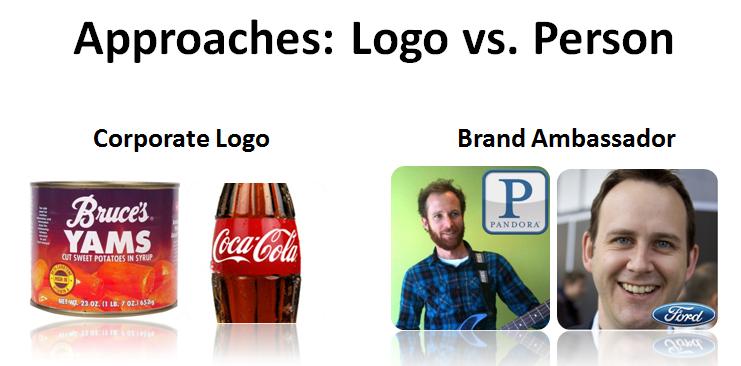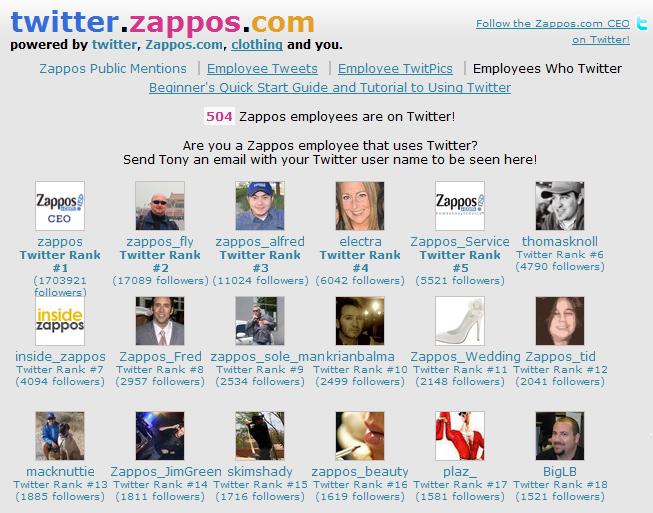This is something Zappos has done for years that really needs to catch on more than it has, because:
- The rewards for corporations are huge, and
- Tthe competition is too risk-averse to do it. And avoiding all risks is not the way to run a winning company.
But first let me tell you what I’m talking about and what I’m NOT talking about.

You still should tweet with your fingers.
But seriously, what I mean is social media people who:
1. Are not the cofounders or CEO of a company
2. The company has empowered to be the or a brand ambassador
3. They do this as themselves, not behind a logo
4. Preferably, this is not a social media outlet, blog, or social media agency, but a company in an older industry
5. Size isn’t a huge factor- but per #1 it probably has to have at least 3 people- all the way up to to a Fortune 100 company

I hate to pick on Bruce’s Yams, because they really took a gutsy risk hiring Miss Destructo to do their social media. But they need to go further and let her be the FACE. Why? As she related to me today, when she went to a conference in New York City, everyone saw her and immediately asked about the yams. People are asking her to speak at social media conferences later this year and talk about the yams. It is impossible to separate the brand ambassador from their work, for good or ill. People already know.
Coca-cola has a funny video about the guys that created their Facebook page, but as far as I know, they are no longer involved. Mistake.
Look at Pandora- originally they had Lucia, who tweeted from behind the logo. Kudos to Pandora, they now have Aaron with his face and guitar, tweeting with his FACE! And Scott Monty is well known as a social brand ambassador and mover and shaker for Ford. His social media success has not only helped Ford’s sales but also garnered them a huge amount of PR. And he tweets with his face.
The Only Thing We Have To Fear Is…
Corporate decision-makers are afraid that tying themselves to a person either limits them (stuck with that person), or increases risk of brand damage. Here’s why those fears aren’t realistic:
- We’ll Be Stuck With Them: Pandora switched from Lucia to Aaron. No biggie. You aren’t stuck with someone.
- They’ll Tarnish Our Brand: Kodak and Jeffrey Hayzlett parted ways. Hayzlett for newer and bigger opportunities, and from what he’s said in interviews, I’m guessing Kodak corporate PR is relieved. They didn’t like when he tweeted the reply “Bite me”, or when he said more politely “Please bite me.” But there’s no evidence that’s the reason they parted ways, and there’s no evidence that Kodak’s brand was injured. In fact, there’s plenty of evidence that the boisterous Hayzlett increased Kodak’s brand visibility in social media.
Social Media Brands, Buying Decisions, and Stock Prices
If you think Kodak likes telling people “bite me”, you’re delusional. Get real. Kodak does cameras. If I buy a Kodak, it will be based on camera reviews, not because their FACE on Twitter said something questionable. If a social brand ambassador does say something inappropriate, just fire them and move on. That sends a clear message: this is not what our company is about.
One of the biggest things social media does is increase visibility and mindshare. Even the negative opinions social media moms had about Motrin won’t keep me from buying Motrin if it’s the right medication for the situation. I’d probably buy the CVS version, anyway. Motrin Moms didn’t change my buying behavior. Regardless, this supposed debacle didn’t affect their bottom line or stock price.
How Corporations Can Leverage Social Networking
Social networking is super powerful. It…
- Seeds word of mouth
- Builds trust
- Increases mindshare
- Increases repeat purchasing
The problem for big brands is: personality is required. I don’t want to be friends with a logo. I want to be friends with a person. Social networking has major ROI in a variety of ways, but it only works between real people.

One way to mitigate the risk to your brand is take the Zappos approach. They’ve had 500+ employees on Twitter, tweeting with their own FACES, for years. Zappos saw themselves as a customer service company, and that’s one of the reasons they dove headlong into Twitter. Amazon acquired them for nearly $1 billion dollars. Not too shabby.
What’s funny is that Zappos never really told them what to tweet. Conversely, Coca Cola has 20 principles and you have to be certified. They can’t get as simple as Sun’s 3 social media principles. Does Coke just hired dumber people? More likely, they’re more scared. They have the most valuable brand in the world; the brand itself was valued at $68 billion in 2009. Just the brand. But you know what’s going to happen- some befaced Coca-Cola twitterer is going to tweet out a bad word and the brand is going to suddenly be worth $34 billion. Seriously?
I’m trying to think of a “get some guts” command that doesn’t sound vulgar.
Oh well.
Nonetheless, you may want some Social Media policies, so here are 113 of them you can use as examples.




